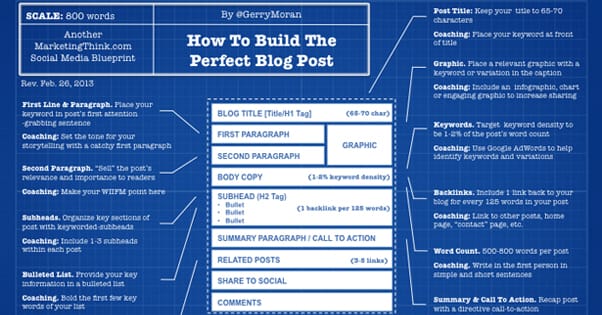How to Train an Employee to Write for Your Company Blog
Published by Drew Hendricks • Content Marketing • Posted June 15, 2016 ContentPowered.com
ContentPowered.com
Content marketing has always been popular, but in recent years the field has been doused in rocket fuel and set on fire. There’s the upswing of content marketing on a general level — any company that doesn’t have a blog is not seen as having a voice in its industry.
Then there are the statistics. There are countless numbers out there that show why content marketing is on the rise. The most indicative number says that 78% of Chief Marketing Officers believe that custom content marketing is the future of marketing as a whole. That’s a strong showing from the execs at the top of the marketing world.
I’m saying all this because if you’re wondering how to train an employee to write for your company blog, you’ve clearly decided that custom content marketing is the way to go.
Good call. I agree with you.
While most companies agree that content is important, a lot of them still outsource that content. This can be effective in terms of cost, but you just won’t get the deep, honest articles on your niche.
The trouble with hiring in-house writers is that it’s expensive. You want them to come out of the gates not just running, but on top of a thorough-bred horse who’s galloping like the wind. The reality is that deciding to employ an in-house writer for your blog is a long game, and the ROI will be seen in the future, not next week.
If you’re ready for that mentally, good, just make sure you don’t promise a 15% spike in sales the week after your writer publishes their first post. It doesn’t work like that.
I’m going to break up this how to article into three different sections. The first is if you’ve hired or promoted someone within your company to start writing your blog. The second will be if you’ve hired an entirely new person, outside the company, to come on board. Both are totally legitimate, and each has its pros and cons. The third is general advice for all writer trainers.
Let’s get to it!
Training a Writer Who Already Works For You
In some ways this is the easier of the two processes, but only if the employee has a decent grasp of the written word. I’ll assume that’s the case, and you didn’t decide to take a mute from the foreign-language hire from development team and throw them on blog-duty. (Hint: That’s a terrible idea).
With the assumption that the person can write well, this is the best sort of hire, because they already know your product and niche. Whether they were working in customer service, HR, or marketing before this new writer role, they have hands-on experience with the customers you are trying to retain and the inner workings of the company.
This cuts out a lot of the training.
What you’ll need to focus on is making sure they understand the difference between blog writing and other types of writing.
Blog Writing Vs. Writing
Stringing words together is necessary for this position, and doing it well is a feat in of itself. Blog writing has a unique set of principles that make it different from writing an essay, a journalistic piece, a humor piece, or something creative. It is most similar to journalism, but still not the same.
Each of those elements should be infused stylistically into the writing, but the format of every article needs to have a definitive blog approach, as do certain key aspects.
There are four components to blog style writing:
1. Authority on the topic
This is key to any excellent blog writer, and something you’ll need to train into your writer at every possible opportunity. Excellent blogs are ones in which information is given clearly, concisely, and with authority.
Authority here means a commanding knowledge of your niche, company, or topic to the point where the reader will trust what is written. Of course, the information your writer includes in the article needs to be accurate, so this first and most important step will train them to not only sound like an authority for your niche, but be an authority.
If you have a good writer they’ll be able to do this simultaneously, learning to be more authoritative in their written word and their actual knowledge at the same time.
This requires time and research, so be patient. Give them as much research time for authority on difficult topics as necessary.
The last thing you want is an article that isn’t authoritative, because nobody will read that and take action.
2. Invoke Action
Most blog posts, either explicitly or subliminally, ask the reader to take action. This is markedly different from other forms of writing. The action can be very clear. For instance, if somewhere in this article I wrote, “Hire me to train your blog writers,” it would be a clear call to action.
There’s also the subliminal call to action, which is actually embedded in almost all blog posts by nature. For instance, you’re reading this on Blogpros, which is a service that gets you more shares on the blog posts you write. There’s always the underlying idea that you might use Blogpros because you’ve landed on this site to read this article.
This, in fact, is the entire point behind custom content marketing in the form of a blog. Nobody actually makes much money from an article, they make money from the people the article gathers, who then go and buy the product of the company.
Make sure your writer knows the difference between explicit and subliminal actions and how to write in a way that invokes them. Also, be clear on which you want and why. Even the best of writers aren’t mind readers, and if you’re not clear you could end up with blog posts that seriously over promote your business, which is tacky.
3. Headlines and Openings
I’m grouping these together because you may not require your writer to come up with headlines. Often a higher-up person will think of the headlines, because that’s basically article generation for your company, which your own team should be discussing frequently.
If they do have to come up with the headline, make sure to test their ability to do this and train them regularly on your preferences. Headlines are very difficult to get correct. It’s really a separate task and topic, so I’d suggest not saddling your writer with headlines to start out.
If you want them to eventually take over the role, direct them to comprehensive articles on the subject.
Your writer will need to be excellent at opening a blog post. An opening is 2-6 paragraphs depending on the subject, the length of the article, and how much juice you want them to splice into their words. It should let the reader know what the topic is, what the overall context for that topic is, and provide a good, relatable report for the reader to engage with.
This is key to good blog writing. Readers will scan the first couple paragraphs to see if they like how the article is written, then scroll through the article to find the sections they care about. If that first scroll relates a dully written article, they are less likely to continue reading at all.
4. Structure
The last major component to blog writing is structure. Train your writer to steer clear of massive blocks of texts. Writing an essay and a blog post are two entirely different things.
Have them use headings, sub-headings, and lists (just like this one) effectively. This lets readers scan through articles to find the sections they care about.
Hopefully this step will be relatively easy for your writer, and you won’t have to train them out of the habit. It’s a bit like outlining — just have them outline the article first, then fill in with paragraphs. A blog post, in a way, keeps the original outline visible and makes it sound good.
Training a New Hire Writer for Your Company Blog
The above four steps are all about making sure your new blog writer, who was already working in the company, would get on board fast. This section will be about how to train an entirely new hire.
First off, your new hire should already have extensive writing and blogging experience. I’ll assume this is the case, because what company hires a person without prior experience in the job they’re being hired for?
As such, that person should already know a good deal about the steps above. The specifics of blog writing will come naturally to them.
What this means is that your new writer will need to learn about your company, how you do things, and who your clients or customers are. Here are the basic fields you need to cover when training your brand new hire.
Who They’re Writing For
This is probably the most important aspect of training a new hire. Who exactly are they writing for? This ties into what your marketing strategy is, who your current clients are, and who you want your future clients to be.
Giving your new writer a clear perception of his/her audience will enable him to better wield his words so that they work in your favor.
If you’re a construction company that needs blog posts a construction foreman will understand, make sure your writer can craft a compelling argument for that audience. Talking about family, long days, safety, overtime, and on-site insurance is all necessary, but the way in which they write about it is as important.
I don’t want to get too stereotypical (because there’s no general audience), but inform your writer of your client’s background, education, interests, and common verbiage so they can connect with them on that level.
The same goes for any other industry. If it’s an academic blog, have your writer use big words. If it’s a technology blog, have your writer make asides about coding and Silicon Valley.
All of this is about building an automatic connection to your audience, so make sure your new writer knows who that audience is.
The Ins and Outs of Your Company
In addition to the clients or customers you have, it’s just as important that your new writer be fully versed in your company. Hopefully you hired somebody who already has some knowledge of your niche, but often times companies will bring on people who can write, but haven’t necessarily written in their industry.
This is a standard practice that, while not ideal, certainly works.
You’ll need to have a frank discussion with your new writer about their knowledge of your company’s niche. Get to the nitty-gritty here, because to write an effective blog post they will need to be authoritative (see above), and getting to that level means really understanding your industry.
A good writer will perform this task well and write articles that mostly hit the mark. A great writer will ask to get knee-deep in sales pitches, board meetings, live demos, on-site jobs, and pretty much every aspect of your business.
Writers are learners and researchers by trade, so let them do those things. In fact, encourage it.
This, again, might look like it’s eating into your ROI. You hired a writer and they want to spend a week sitting in on sales calls? Make them write! Right?
Not so much. Sure, give them deadlines and assignments, but know that the quality of your blog posts will significantly increase when your new writer is fully immersed in their topic. The words will bleed out of them; they will be able to get fully creative and inspirational, motivational, and actionable once they have knowledge of their topic.
Make that happen for them, and your blog will get read.
Synergy
It’s a hot-button word, sure, but the concept is sound. Your new hire is not just a new employee, but one that has to represent the company with the written word. That’s a big task.
Make sure they are clued into the ideological conversations at the company so those can be reflected in the blog posts. This means one big thing from you, the boss: communication.
Whether this means allowing the writer to sit in on bigger meanings and do their own strategizing for how to work new company policies into blog posts subtly, or giving them the low-down once or twice a month, it’s your responsibility to enact synergy in the office.
General Tips for Training a New Writer
While the above details specific ways you should train a writer based on the nature of their hiring, there are two general tips that apply to all writers and all trainers.
Provide Examples
Unless you’ve hired a writer that’s supposed to double as the head of marketing, you’ll want to provide them with examples of what you’re looking for. Yes, you could ask them to draft articles on topics of your choice and then heavily critique them when they’re not what you wanted, but the kind thing to do is give them examples.
Most companies will have had a blog or something like blog posts in the past, so direct your new writer to these. Do more than just say “read these,” though. Tell them what you liked, what you didn’t like, what needs changes, and why. Be thorough, because a good writer will really listen to what you want, take an example, and produce something brilliant.
If you don’t have any previous examples of blog posts, consider writing one to give them as an example. This again might some counterproductive — you’ve just hired a writer to do the writing, why should you do it?
Well, two reasons. You’ll get a sense of the effort it takes to write a good blog post, and the concept of your blog will actually become much clearer to you.
If you write something specifically for the writer to reference and analyze it will also cement an immediate bond between the two of you — it shows you’re willing to get on their level to produce a great article.
Edit Their Work and Have Them Read the Final Product
The final thing you should do for every new writer is to make sure their work gets edited, and then have them read the finished piece. You’ll find that some writers may be good editors, but no writer can produce top-notch work without a little editing from an outside perspective.
Take their article and run it by an official editor for grammar, spelling, and overall tone. If there any major changes or discrepancies, talk about these with the writer and either inform them why parts of the blog are not working, or hear their side of things.
Finally, after editing, have your writer read through the published version. If your editorial team is good your new writer will quickly see what their weaknesses are and how they should morph to the company’s blog style.
Train Away
Hopefully this how to article helps your training process! Remember, writers are often thoughtful, curious, and hands-on. Meet them halfway and you’ll have a fantastic blog.











